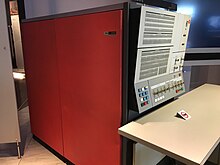
IBM System/360
IBM mainframe computer family (1964–1977) / From Wikipedia, the free encyclopedia
Dear Wikiwand AI, let's keep it short by simply answering these key questions:
Can you list the top facts and stats about IBM System/360?
Summarize this article for a 10 years old
The IBM System/360 (S/360) is a family of mainframe computer systems that was announced by IBM on April 7, 1964, and delivered between 1965 and 1978.[1] It was the first family of computers designed to cover both commercial and scientific applications and a complete range of applications from small to large. The design distinguished between architecture and implementation, allowing IBM to release a suite of compatible designs at different prices. All but the only partially compatible Model 44 and the most expensive systems use microcode to implement the instruction set, featuring 8-bit byte addressing and binary, decimal and hexadecimal floating-point calculations.
 | |
 IBM System/360 Model 30 central processor unit (CPU) | |
| Also known as | S/360 |
|---|---|
| Developer | IBM |
| Manufacturer | IBM |
| Product family | See table of models |
| Type | Mainframe computer |
| Release date | April 7, 1964 (1964-04-07) |
| Discontinued | 1978 (1978) |
| Media | |
| Operating system | |
| Memory | 8 KB – 9 MB (core memory) |
| Predecessor | 700/7000 series |
| Successor | System/370 |
| Related | System/360 architecture |
| History of IBM mainframes, 1952–present |
|---|
| Market name |
| Architecture |
The System/360 family introduced IBM's Solid Logic Technology (SLT), which packed more transistors onto a circuit card, allowing more powerful but smaller computers.[2]
The slowest System/360 model announced in 1964, the Model 30, could perform up to 34,500 instructions per second, with memory from 8 to 64 KB.[3] High-performance models came later. The 1967 IBM System/360 Model 91 could execute up to 16.6 million instructions per second.[4] The larger 360 models could have up to 8 MB of main memory,[5] though that much memory was unusual; a large installation might have as little as 256 KB of main storage, but 512 KB, 768 KB or 1024 KB was more common. Up to 8 megabytes of slower (8 microsecond) Large Capacity Storage (LCS) was also available for some models.
The IBM 360 was extremely successful, allowing customers to purchase a smaller system knowing they could expand it, if their needs grew, without reprogramming application software or replacing peripheral devices. It influenced computer design for years to come; many consider it one of history's most successful computers.
System/360's chief architect was Gene Amdahl, and the project was managed by Fred Brooks, responsible to Chairman Thomas J. Watson Jr.[5] The commercial release was piloted by another of Watson's lieutenants, John R. Opel, who managed the launch of IBM’s System 360 mainframe family in 1964.[6]
Application-level compatibility (with some restrictions) for System/360 software is maintained to the present day with the System z mainframe servers.